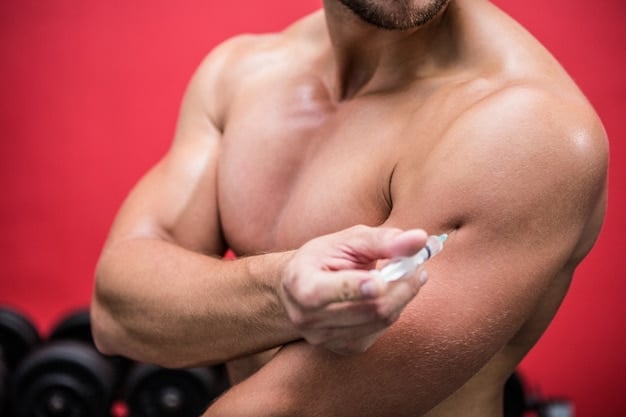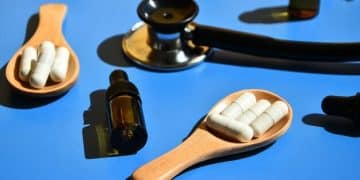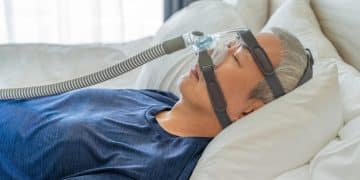Understanding the Risks and Benefits of Testosterone Replacement Therapy in 2025

Understanding the Risks and Benefits of Testosterone Replacement Therapy in 2025 involves carefully weighing potential improvements in energy, libido, and muscle mass against concerns about cardiovascular health, prostate issues, and hormonal imbalances, while considering advancements in delivery methods and personalized treatment approaches.
Are you considering testosterone replacement therapy (TRT) in 2025? It’s a decision that requires careful consideration. **Understanding the Risks and Benefits of Testosterone Replacement Therapy in 2025** is crucial for anyone experiencing symptoms of low testosterone, as it involves weighing potential improvements in quality of life against potential health risks.
What is Testosterone Replacement Therapy?
Testosterone Replacement Therapy (TRT) is a medical treatment designed to address low testosterone levels in men. As men age, testosterone levels naturally decline, leading to various symptoms. TRT aims to restore these levels, potentially improving overall well-being.
But what exactly are the aims of this method? And how does it plan on dealing with the common problems of middle-aged men?
The Purpose of TRT
The primary goal of TRT is to alleviate symptoms associated with low testosterone, such as fatigue, decreased libido, erectile dysfunction, loss of muscle mass, and mood changes. By restoring testosterone levels to a normal range, TRT can help improve these symptoms and enhance overall quality of life.
Forms of TRT Available
TRT is available in various forms, each with its own advantages and considerations. Here are some common methods:
- Injections: Testosterone injections are administered directly into the muscle, typically every one to two weeks.
- Topical Gels: These gels are applied daily to the skin, allowing testosterone to be absorbed into the bloodstream.
- Patches: Transdermal patches are applied to the skin and release testosterone gradually over a 24-hour period.
- Oral Medications: While less common due to potential liver toxicity, oral testosterone medications are available.
Choosing the right form of TRT depends on individual preferences, lifestyle, and medical considerations. Consulting with a healthcare provider is essential to determine the most suitable option.
In conclusion, TRT offers a potential solution for men experiencing symptoms of low testosterone. By understanding the aims and available forms of TRT, individuals can make informed decisions about their health and well-being.
Benefits of Testosterone Replacement Therapy in 2025
The potential benefits of Testosterone Replacement Therapy (TRT) extend beyond simply addressing low testosterone levels. In 2025, advancements in TRT continue to offer a range of improvements for men experiencing symptoms of deficiency.
Let’s take a look at what these benefits may be:
Improved Energy and Mood
One of the most commonly reported benefits of TRT is an increase in energy levels and an improved mood. Low testosterone can lead to fatigue and feelings of depression, anxiety and the use of TRT has shown to improve overall vitality and emotional well-being.
Increased Muscle Mass and Strength
Testosterone plays a crucial role in muscle development. TRT can help increase muscle mass, strength, and physical performance. This can be particularly beneficial for older adults looking to maintain their physical function and independence. This is crucial to improve not only every day life but also self-esteem.

Enhanced Sexual Function
Testosterone is essential for sexual health. TRT can improve libido, erectile function, and sexual satisfaction. For men experiencing difficulties in these areas due to low testosterone, TRT can offer significant benefits.
Other Potential Benefits
- Improved bone density, reducing the risk of osteoporosis.
- Enhanced cognitive function and memory.
- Better sleep quality, reducing insomnia and sleep disturbances.
In summary, TRT offers a multitude of potential benefits for men experiencing low testosterone levels in 2025. From improved energy and mood to increased muscle mass and enhanced sexual function, TRT can significantly enhance quality of life. However, it’s crucial to weigh these benefits against the potential risks and consult with a healthcare provider to determine if TRT is right for you.
Potential Risks and Side Effects
While Testosterone Replacement Therapy (TRT) offers numerous potential benefits, it’s essential to be aware of the associated risks and side effects. Understanding these potential drawbacks is crucial for making informed decisions about TRT.
It is important to ask, what are the side effects and are they dangerous or not?
Cardiovascular Risks
Some studies have suggested that TRT may increase the risk of cardiovascular events, such as heart attack and stroke. However, the evidence is mixed, and more research is needed to fully understand the cardiovascular effects of TRT. Individuals with pre-existing heart conditions should exercise caution when considering TRT.
Prostate Issues
TRT can stimulate prostate growth, potentially leading to benign prostatic hyperplasia (BPH) or prostate cancer. Men with a history of prostate issues should be closely monitored while on TRT. Regular prostate exams and PSA (prostate-specific antigen) testing are essential.
Other Potential Side Effects
Besides the most serious ones there are side-effects worth taking in consideration:
- Acne and oily skin.
- Sleep apnea.
- Gynecomastia (enlargement of breast tissue).
Managing Risks and Side Effects
To minimize the risks associated with TRT, it’s crucial to work closely with a healthcare provider. Regular monitoring of testosterone levels, prostate health, and cardiovascular function is essential. Adjustments to the dosage or form of TRT may be necessary to manage side effects.
Awareness of the potential risks and side effects of TRT is essential for making informed decisions about your health. By understanding these potential drawbacks and working closely with your healthcare provider, you can minimize risks and maximize the benefits of TRT.
Advancements in TRT Delivery Methods in 2025
In 2025, Testosterone Replacement Therapy (TRT) has undergone significant advancements in delivery methods, offering greater convenience, efficacy, and patient satisfaction. Staying informed about these innovations is essential for anyone considering TRT.
But what modern methods exist and how do they plan to improve the process?
Transdermal Patches and Gels
Transdermal patches and gels have become increasingly popular due to their ease of use and consistent testosterone delivery. In 2025, these methods have been refined to improve absorption rates and minimize skin irritation. Newer formulations offer faster drying times and reduced transfer risk to others.
Long-Acting Injectable Formulations
Long-acting injectable formulations of testosterone offer the convenience of less frequent injections, typically every two to three months. These formulations utilize advanced technology to release testosterone slowly and steadily, maintaining more stable hormone levels and reducing fluctuations.

Nasal Gels
Nasal gels deliver testosterone through the nasal mucosa, providing rapid absorption and avoiding first-pass metabolism in the liver. This method offers a convenient and non-invasive alternative to injections and topical applications. However, some individuals may experience nasal irritation or discomfort.
The Future of TRT Delivery
With all the already existing methods, it is a safe bet to claim that technology and science will provide other ways to deliver and apply this medication.
- Development of implantable testosterone pellets that release testosterone over several months or years.
- Personalized TRT regimens based on individual hormone levels and genetic factors.
Advancements in TRT delivery methods in 2025 offer a range of options tailored to individual preferences and lifestyles. From transdermal patches to long-acting injectables and innovative nasal gels, these advancements provide greater convenience while delivering stable hormone levels. Staying informed about these innovations is essential for making the most of TRT.
Lifestyle Factors and TRT Effectiveness
While Testosterone Replacement Therapy (TRT) can provide significant benefits for men with low testosterone, lifestyle factors play a crucial role in determining its effectiveness. Adopting healthy habits can enhance the results of TRT and improve long-term outcomes.
Let’s elaborate on how lifestyle choices can amplify the efficacy of TRT:
Diet and Nutrition
A balanced diet rich in protein, healthy fats, and essential nutrients is vital for optimizing testosterone levels and overall health. Consuming adequate protein supports muscle growth and repair, while healthy fats are essential for hormone production. Avoiding processed foods, sugary drinks, and excessive alcohol intake is recommended.
Exercise and Physical Activity
Regular exercise, particularly resistance training, can boost testosterone levels and enhance the effects of TRT. Strength training helps build muscle mass, which further increases testosterone production. Cardiovascular exercise improves overall cardiovascular health and fitness, reducing the risks associated with TRT.
Stress Management
Chronic stress can suppress testosterone production and interfere with the effectiveness of TRT. Practicing stress management techniques, such as meditation, yoga, or deep breathing exercises, can help lower cortisol levels and promote hormone balance. Getting adequate sleep is also crucial for stress management and hormone regulation.
Additional Considerations
With the topics above, it is key to mention additional considerations to help optimize the effectivity of TRT besides lifestyle:
- Regular monitoring of testosterone levels and overall health is essential for optimizing TRT and minimizing risks.
- Consulting with a healthcare provider or registered dietitian can help develop a personalized diet and exercise plan tailored to individual needs.
Lifestyle factors play a significant role in determining the effectiveness of TRT. By adopting healthy habits such as a balanced diet, regular exercise, and stress management techniques, individuals can enhance the benefits of TRT and improve their overall well-being.
Future Trends in Testosterone Replacement Therapy
Looking ahead, Testosterone Replacement Therapy (TRT) is poised for further advancements and innovations that promise to enhance its safety, efficacy, and personalization. Staying informed about these future trends is essential for those considering TRT in the years to come.
So what does the crystal ball say will happen in the future?
Personalized TRT Regimens
Future TRT regimens are likely to be more personalized, taking into account individual hormone levels, genetic factors, lifestyle, and overall health. Advanced diagnostic tools and biomarkers will help identify the underlying causes of low testosterone and tailor treatment accordingly. This approach will optimize TRT outcomes while minimizing risks.
Targeted Therapies
Research into targeted therapies for low testosterone is expected to yield new treatments that specifically address the underlying causes of hormone deficiency. These therapies may include novel medications, gene therapies, or stem cell treatments that stimulate natural testosterone production. This approach could offer a more sustainable and physiological alternative to conventional TRT.
And what innovations will there be?
The most probable next step would be the following:
- Development of non-invasive monitoring technologies for continuous testosterone level tracking.
- Integration of artificial intelligence (AI) and machine learning (ML) to optimize TRT dosage and monitoring.
The future of TRT holds exciting possibilities for more personalized, targeted, and effective treatments. From personalized TRT regimens to regenerative therapies and innovative delivery methods, these advancements promise to revolutionize the management of low testosterone and improve men’s health and well-being. Keeping abreast of these future trends is essential for anyone considering TRT in the years ahead.
| Key Point | Brief Description |
|---|---|
| 💪 Muscle Mass | TRT can boost muscle mass and strength. |
| ❤️ Cardiovascular Risks | Some studies suggest potential heart risks. |
| 🧍 Lifestyle Impact | Diet and exercise enhance TRT effectiveness. |
| 🧪 Monitoring | Regular check-ups are vital during TRT. |
Frequently Asked Questions
▼
The primary goal of TRT is to alleviate symptoms associated with low testosterone, such as fatigue, decreased libido, and loss of muscle mass, improving overall well-being.
▼
Some studies suggest a potential increased risk of cardiovascular events, such as heart attack and stroke, but more research is needed for conclusive evidence.
▼
A balanced diet rich in protein and healthy fats supports hormone production and muscle growth, enhancing the effects of TRT while avoiding processed foods and excessive alcohol.
▼
Advancements include improved transdermal patches and gels with faster absorption, long-acting injectable formulations for less frequent injections, and nasal gels for rapid hormone delivery.
▼
Yes, regular exercise, especially resistance training, can boost testosterone levels, enhance muscle growth, and improve cardiovascular health, complementing the effects of TRT.
Conclusion
In conclusion, **understanding the risks and benefits of testosterone replacement therapy in 2025** involves navigating a landscape of advancements and potential drawbacks. It’s imperative to consult with healthcare professionals, carefully weigh individual circumstances, and adopt a holistic approach to health to make informed decisions about TRT.





